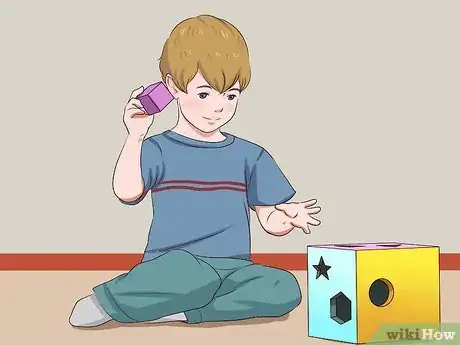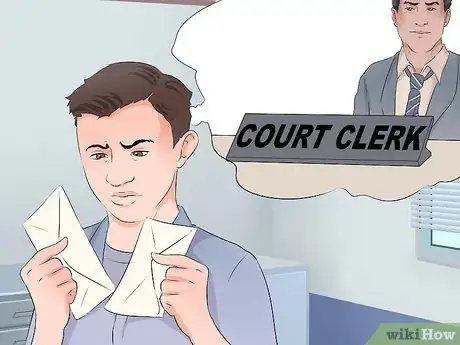This article was co-authored by Clinton M. Sandvick, JD, PhD. Clinton M. Sandvick worked as a civil litigator in California for over 7 years. He received his JD from the University of Wisconsin-Madison in 1998 and his PhD in American History from the University of Oregon in 2013.
There are 12 references cited in this article, which can be found at the bottom of the page.
This article has been viewed 28,206 times.
Parents who do not have full custody of their children will often apply for visitation rights.[1] Visitation rights are legal rights granted by a court allowing the parent without custody to visit and spend time with their child within certain limits.[2] While judges have the ultimate decision making power about visitation, parents can write and submit their own agreement, which can be accepted by the court if the judge finds it fair and legal. If you and the other parent cannot agree on your own, you will have to go through the legal process in order to have a judge make a decision for you. Follow the directions below to either create your own agreement or go through the court process.
Steps
Making Your Own Visitation Agreement
-
1Define the parties to your agreement. The first step in making a visitation agreement is to set out who will have visitation rights. While this will most often be the parent not having custody of the child, there are situations where other individuals may get visitation rights. For example, in Washington State, a person other than a parent can have visitation rights if it is in the best interest of the child.[3] Regardless, provide a detailed description of all parties to the agreement, which should include names, addresses, contact information, and their relationships to the child.
- Such a provision may look like this: "I, Jane Doe, am the parent of Kevin Doe and I have full custody of that child. I agree to allow John Doe, the father of Kevin Doe, visitation rights as set forth and agreed upon below. Jane Doe lives at [address] and can be contacted in the following manner [provide contact information]. John Doe lives at [address] and can be contacted in the following manner [provide contact information]."
-
2Include a provision about the child or children at issue. Once you have defined the parties to the agreement, you will want to include a detailed discussion about the child. Such a clause should include information about the child's basic needs, which will include their need for love, support, guidance, and health.[4]
- A good example of this type of provision may take the following form: "Kevin Doe is the child of John and Jane Doe. John and Jane Doe are creating this agreement to allow Kevin's father, John, certain visitation rights. Kevin wants and needs the love and support of both parents and therefore John should have certain visitation rights in order to provide certain basic needs. Kevin is currently nine years old as of the date this agreement is executed, and having his father involved in his life is in the child's best interests. Kevin and John have always been close and have had a good relationship. This agreement will help maintain and further the relationship they already have. Kevin is currently in good health and allowing John visitation rights will help maintain and promote this good health."
Advertisement -
3Detail both physical and legal rights. This section will be the body of your agreement and will set forth all of the rights and obligations of the parent or other person receiving visitation rights. When creating this section, consider the child's age, personality, experiences, and abilities. [5] You should also try to give the child a regular and consistent schedule that can easily be followed.[6] Use enough detail so that the agreement is easily understandable and enforceable.[7] Also, the agreement should give the child a sense of security and a reliable routine.[8]
- Physical custody includes information about where the children live and how they spend their time.[9] When writing this section you should think about where the children should be during the week and on the weekends; where the children should be for holidays and other special occasions; which party will be in charge of what activities (sports, music events, homework); which party is in charge at what times; and how the children will get from one place to the other.[10]
- Legal custody includes information about which party to the agreement will make important decisions regarding the child.[11] When you write this section be sure to include information about decisions regarding school, daycare, religion, medical and dental care, emergency care, jobs, and driving.[12]
-
4Go through mediation if necessary. If at any time during the drafting process you and the other party do not agree to certain terms, you may want to consider trying mediation. During mediation, both parties will have the help of an expert (mediator) to try and resolve their differences.[13] The mediator will talk with both parties about their concern, disagreement, resentment, and anger.[14] The mediator will then try and come up with an amicable solution that makes you and the other party happy. If successful, the mediator may even help you draft language into your agreement that reflects the progress you made during your time with that mediator.[15]
-
5Fill out required court documents. Once you have completed your agreement, you will need to attach other required documents to your agreement in order to have a judge review your plan.[16] In general, the following document will be required along with your written agreement:
- Stipulation and Order for Visitation of Children, which will require you to sign a document stating that the court has jurisdiction over the children at issue and that you are agreeing to the terms of the agreement attached to this document.[17]
-
6Get the judge's signature. Once you have filled out the required documentation and attached it to your written agreement, you will go to your local courthouse and have the documents signed by a judge.[18] The judge will look over your agreement and ensure everything included is in the best interest of the child. If the judge approves of your agreement, they will sign it and give it back to you. If the judge denies your agreement, you will have to start over or go to court.
-
7File everything with the clerk of courts. Once the judge has signed your agreement, you will file all of the signed documentation with the clerk of courts at your local courthouse.[19] Once filed, you and the other party to your agreement will get copies and the agreement will then be binding on everyone involved.[20]
Going to Court
-
1Consider hiring an attorney. If you can afford a family law attorney, you should consider hiring one to help you navigate the legal pathway to gaining visitation rights. See this article for directions on how to find a good family law attorney. Even if you cannot afford a full-service attorney, many attorneys provide limited services at a reasonable cost. This means you may be able to hire an attorney to prepare your documents, give you limited legal advice, or potentially even teach you about this area of the law, without having to pay the attorney to take on the entire visitation process.
-
2Fill out the required forms. In order to start the process, you will need to fill out the forms necessary to bring a legal action to ask the court for visitation rights. Each state will have their own forms and own requirements. In general, you will have to fill out a petition or visitation rights, sometimes called a petition for custody and support.[21] In addition, you will have to attach a summons and a response form to your petition.[22]
- The petition for visitation rights will ask you about your relationship with the child at issue and will ask you to clarify the types of visitation rights you are seeking.[23] If you are in California, a copy of this petition can be found here.
- The attached summons is a document notifying the other party that they have been sued and that they must respond to the lawsuit within a certain period of time or they risk losing some or all of their parental rights.[24] In California, the summons states that the party is being sued and that they have 30 days to file a response.[25] A copy of the California summons can be found here.
- In order to allow the other party you are suing to respond, you must attach a blank response form for them to fill out and return. In California, a blank response form can be found here.
-
3File your documents. Once you have filled out your petition for visitation and you have attached a summons and blank response form, you will take those documents to your local courthouse and file them with the clerk of courts. They will enter the case into the court's docket and you will be given a hearing date. Once you complete this process, you have officially started a lawsuit in an attempt to get visitation rights.
-
4Serve the other party. When you serve the other party, you will hire someone (the sheriff or another competent adult) to give a copy of your filed documents to the other party to look over and respond to. To serve the other party, the person you hire must provide the required documents to them, either in person or through the mail.[26] If you are serving someone through the mail, it must be sent by certified mail. This process must be completed within 30 days of filing your documents with the court.[27]
-
5Wait for a response. Once you have had the other party served, they will have a set amount of time with which to respond to your petition. In California, the other party will have 30 days to respond to your petition by filling out the blank response form you provided. The other party can respond in a number of ways, and how they respond will dictate how your lawsuit proceeds.
- If the other party does not contest your request for visitation, the court may simply enter its final order without having to go through a hearing.
- If the other party is contesting your request for visitation, you will have to go to your hearing and tell the judge why you deserve the visitation rights you are asking for.
-
6Attend your hearing. When you go to your hearing, the judge will make a decision about visitation rights based on the law of the state you are in. In California, the judge must hand out visitation rights according to what is in the "best interests of the child."[28] In making this decision, a judge will look at the child's age and health, the emotional ties between the parent and the child, the ability of the parent to care for the child, any history of family violence, and the child's ties to the community (e.g., schools and friends).[29] If the other party is contesting your fitness as a parent, and is therefore claiming you should not get visitation rights, try using the following evidence to help your argument that visitation rights would be in the best interest of your child.
- Provide evidence of your financial stability. This information will show the judge that you can care for the child and take care of their basic needs. Some helpful documents might include bank statements, pay stubs, and investment account information.
- Show your ability to provide a safe and secure home for the child. This information will help the judge understand what safeguards you have in place to ensure you are looking out for the best interests of the child. You might provide the judge with pictures of your home, bills for home security payments, and written or verbal testimony of neighbors, friends, and family about the safety of your neighborhood and your home.
- Offer evidence of your ability to provide healthcare for the child. Try and have documentation proving you are insured and that your coverage includes your child.
- Demonstrate the strength of your relationship with your child. Let the judge know how close you are with your child. Tell the judge about the past and how your relationship was when you had custody of the child. You might even provide the judge with home videos, trophies, and ticket stubs.
- Indicate how you will spend time with your child. Give the judge a mock schedule or calendar showing how well you can plan your time with the child. Include possible activities and trips you could go on with your child. Be as detailed as possible as this will let the judge know how much you care and how serious you are taking the matter.
- Confirm your intentions to live in one place and provide your child with a stable school environment. An important aspect of gaining visitation rights is your ability to provide your child with a stable home environment. Prove to the judge that you have a good job, that you have no plans to move, and that you will do everything in your power to give your child a steady environment. If you are looking for visitation rights during the week, this will include showing the judge that you live within a reasonable distance of where your child goes to school.
-
7Comply with any of the judge's requests. Before a judge issues their final order, they may ask you to do certain things to prove that having visitation rights is in the best interest of the child. One of the most common requests is for a child custody evaluation. If a judge requires it, there will be an evaluation and analysis, by an expert, who will come to your home and make a determination about your fitness to have visitation rights.[30] The expert's evaluation will then be passed on to the judge for them to analyze.
-
8Receive the judge's final order. Once a judge has all the information they need to make a decision, they will enter a final order, which will include a decision about what visitation rights you will get, if any. If a judge allows visitation, it may take one of many forms. The most common forms of visitation include:
- Visitation According to a Schedule. If your visitation rights have been limited to a schedule, the schedule will lay out what days of the week you can visit, what holidays you will be responsible for, and the time constraints on those visits.[31]
- Reasonable Visitation. If you have been awarded reasonable visitation rights, there generally will not be any details as to when each parent will be with the child.[32] Instead, these orders are open-ended and allow the parents to work out the details among themselves.[33]
- Supervised Visitation. If the judge has ordered supervised visitation rights, you will only be allowed to see the child while under the supervision of another person.[34] This type of visitation is usually only ordered when the health or safety of the child is at issue.[35]
References
- ↑ http://singleparents.about.com/od/visitation/a/parent-child-visitation-rights.htm
- ↑ http://dictionary.reference.com/browse/visitation%20rights
- ↑ http://app.leg.wa.gov/rcw/default.aspx?cite=26.09.240
- ↑ http://www.courts.ca.gov/15872.htm#writeup
- ↑ http://www.courts.ca.gov/15872.htm#writeup
- ↑ http://www.courts.ca.gov/15872.htm#writeup
- ↑ http://www.courts.ca.gov/15872.htm#writeup
- ↑ http://www.courts.ca.gov/15872.htm#writeup
- ↑ http://www.courts.ca.gov/15872.htm#writeup
- ↑ http://www.courts.ca.gov/15872.htm#writeup
- ↑ http://www.courts.ca.gov/15872.htm#writeup
- ↑ http://www.courts.ca.gov/15872.htm#writeup
- ↑ http://www.courts.ca.gov/1189.htm
- ↑ http://www.courts.ca.gov/1189.htm
- ↑ http://www.courts.ca.gov/1189.htm
- ↑ http://www.courts.ca.gov/15872.htm#writeup
- ↑ http://www.courts.ca.gov/documents/fl355.pdf
- ↑ http://www.courts.ca.gov/15872.htm#writeup
- ↑ http://www.courts.ca.gov/15872.htm#writeup
- ↑ http://www.courts.ca.gov/15872.htm#writeup
- ↑ http://www.courts.ca.gov/1192.htm
- ↑ http://www.courts.ca.gov/1192.htm
- ↑ http://www.courts.ca.gov/documents/fl260.pdf
- ↑ http://www.courts.ca.gov/documents/fl210.pdf
- ↑ http://www.courts.ca.gov/documents/fl210.pdf
- ↑ http://www.pacode.com/secure/data/231/chapter1930/s1930.4.html
- ↑ http://www.pacode.com/secure/data/231/chapter1930/s1930.4.html
- ↑ http://www.courts.ca.gov/17975.htm
- ↑ http://www.courts.ca.gov/17975.htm
- ↑ http://www.courts.ca.gov/selfhelp-glossary.htm#childcustodyevaluation
- ↑ http://www.courts.ca.gov/17975.htm
- ↑ http://www.courts.ca.gov/17975.htm
- ↑ http://www.courts.ca.gov/17975.htm
- ↑ http://www.courts.ca.gov/17975.htm
- ↑ http://www.courts.ca.gov/17975.htm










































































